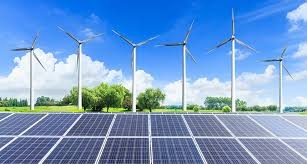Wind-solar hybrid projects were seen as one of the options before the Union government to help it meet the ambitious renewable target of 175 MW capacity by 2022. Nearly a year since their launch, however, projects have seen a slow start, with experts attributing the same to the policy guiding auctions. Of the 3,200 MW of wind-solar hybrid tenders launched in the last one year by central and state agencies, only 2,400 MW have materialised and 1,600 MW been allotted, indicating an under-subscription of 34%. The auctions have witnessed participation from a handful of developers like Adani, Softbank, and ReNew Power.
The tepid response to the tenders even led the Solar Energy Corporation of India (SECI) to cut the capacity of one of its tenders from 2,500 MW to 1,200 MW. Two other wind-solar hybrid tenders, one from NTPC for 174 MW in Karnataka and another for 600 MW in Andhra Pradesh, have got cancelled.
According to industry experts, low ceiling tariffs of `2.7 per unit set by SECI; expectation of a minimum 38% combined utilisation factor (CUF) in the tenders; and lack of good sites are among the reasons impacting hybrid projects. Significantly, the industry has been demanding higher tariffs even as the government has mostly capped tariffs at below `3 per unit. Kameswara Rao, Lead, Energy and Utilities at PwC says, “with project risks in terms of financing, procurement, construction and management of PPAs having gone up across the board, the costs have risen and many bidders are finding it hard to quote within the tariff caps, even where it was possible earlier”.
Jyoti Gulia, founder of JMK Research and Analytics, a Delhi-based renewable consultancy firm, says “having 38% CUF would entail most of the capacity being wind-based. But installing new wind capacities is a challenge since most of the good sites with grid access are already saturated. That is why the last three wind auctions were under-subscribed by nearly 60%.”
Besides land issues, lack of transmission infrastructure is another factor contributing to the weak sentiment. As far as land availability is concerned, states have been reluctant to lease land for central wind projects. To take an example, SECI’s hybrid auction in Gujarat saw a cost escalation after it was clarified that the developers would have to arrange land. As for transmission infrastructure, addition of lines has been low this financial year, with just 4,537 circuit kilometres being added till August compared to 8,172 circuit kilometres in the same period last year.
Shubhranshu Patnaik, Partner, Deloitte India, believes hybrid projects in India are still not acceptable to procurers due to the seasonality of wind speed. “Procurers prefer to buy from a project that guarantees supply when needed. Things can improve for hybrid projects if they are integrated with storage, making power dispatchable on demand,” he says.
Ramesh Khymal, CEO, Siemens Gamesa India (SGI), and the chairman of the CII’s renewable energy and infrastructure sub-committee, continues to bet on the hybrid segment though. “If the government has to achieve its target of expanding the renewable energy base, hybrids with battery back-up is the way to go. It will ensure 24×7 power supply and enhanced capacity,” he feels.
Rao says, “the way ahead for hybrid plants is to combine generation with storage. This would increase the CUF to 40-45% or so depending on the technology used. This is better than what current tenders demand, and, importantly, would give utilities greater control, and make power from such projects more acceptable to them.”

